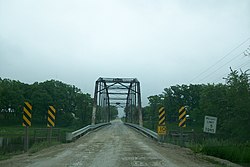Founding
Iowa's entry to the union was approved by Congress on March 3, 1845, with statehood beginning on December 28, 1846, following approval of the state's constitution and boundaries. In order to establish county government across the state, the Iowa General Assembly passed an act on January 15, 1851, which created fifty counties in the half of the state where county government had not yet been established. Humboldt County was created by this act, containing its present area, as well as four townships in present-day Webster County: Jackson, Deer Creek, Badger, and Newark. [3] It was named after Alexander von Humboldt. [4] On January 21, 1855, an act merged the northern half of Humboldt County and Bancroft County into Kossuth County, with the southern half of Humboldt County merging into Webster County. [5]
The Sixth General Assembly passed another act, reestablishing Humboldt County. The act was passed on January 28, 1857, and went into effect on February 26. [5] However, an error omitted the lower four townships (Jackson, Deer Creek, Badger, and Newark) from returning to Humboldt County. The error was not caught until the next session of the general assembly, and the general assembly passed a bill redefining Humboldt County to include the four townships on March 11, 1858. [6] However, in the interceding time, the Constitution of Iowa came into effect, including the provision that "future laws altering county boundaries should be submitted to a vote of the people of the counties concerned and must be approved by them before going into effect". [7] In a court case originating in the disputed area, the Iowa Supreme Court was asked to decide which county court had original jurisdiction. In their clarification, they ruled the March 11, 1858, clarification of Humboldt County's boundaries unconstitutional, as it had not been submitted to a public vote in the counties involved. In his decision, Chief Justice Ralph P. Lowe wrote, "We are compelled to conclude that township 90, in ranges 27 to 30, west of the 5th principal meridian, is still in and forms a part of Webster county. Of course we can pay no attention to conjectural surmises and vague suspicions, which have been made and entertained in relation to some unfairness which may have been practiced in the final passage of the act of 1857, creating the county of Humboldt. If such was the case, no evidence of the fact has been presented to us." [8] The "vague suspicions" include a rumor that John Duncombe of Fort Dodge (namesake of Duncombe, Iowa and plaintiff in the lawsuit) had tricked Humboldt County into ceding the southern four townships to Webster County "on loan", or was otherwise responsible for the "error". [9]
In 1872, Humboldt College was opened and closed in 1916 because there was no agreement with the county about taxation. [10]














